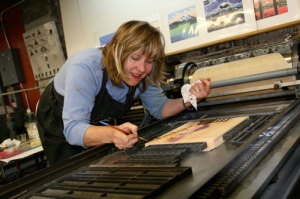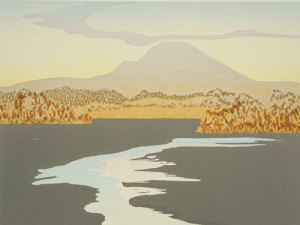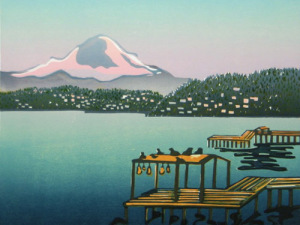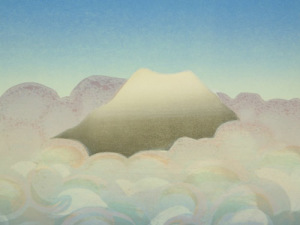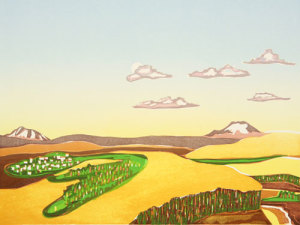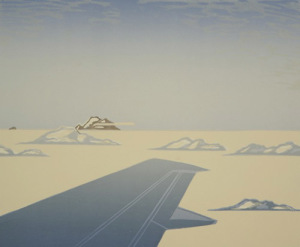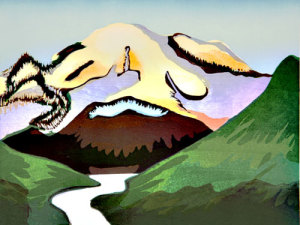Kristina Hagman grew up in New York and Los Angeles and moved to San Francisco to attend college in the late 1970s. Since then, she has lived in New York, Southern California, Tokyo, Santa Fe, and most recently Seattle. Her paintings and prints have been exhibited throughout the United States and Europe. For the last several years, she has focused on a single project: “36 Views of Mount Rainier.” These woodblock prints are an homage to Hokusai’s “36 views of Mount Fuji.” The prints can be seen at the Cullom Gallery in Seattle (www.cullomgallery.com) and on www.kristinahagman.com.
Q: When did you first call yourself an artist?
I spent my young childhood in New York. When I was still small, we moved to the West Coast—away from everything that was familiar. I had terrible dyslexia and failed an important test. I was chubby and unhappy. In the second grade, I won an art competition with some stitchery and the work traveled around the state. Then I knew art was good for me and good to me. But I don’t think I had the presence then to say I was an artist.
Later as an adult, when I studied painting and printmaking, I found it so comfortable that I didn’t think to name myself in that way. After I had children, making art became much more difficult. That’s probably when I really thought of myself as an artist—when it got hard.
Q: Whose works were you drawn to? What were some of your early experiences with art?
In Manhattan, I had a nanny who took me to the Museum of Modern Art. I spent a lot of time with Henri Rousseau. I remember the sleeping gypsy with the lion and water lilies. I loved MoMA, especially the courtyard with the modernist chairs and the oversized female nude sculptures.
We had a big coffee table book at home, and I copied Leonardo da Vinci’s drawings. As a romantic teenager, I was in love with Whistler and the Impressionists. Then when we were in college, I remember seeing abstract Rothkos and Diebenkorns in San Francisco. At John Berggruen’s gallery, I was drawn to Wayne Thiebaud and Nathan Oliveira. Living in Santa Fe, O’Keeffe’s influence, not to mention her subjects, her colors, were all around . Santa Fe drew everybody, and I was able to study with three of those influences, Diebenkorn, Thiebaud, and Oliveira. I also got to know Agnes Martin, who had a great quirky sense of humor.
Q: These prints are rooted in the Japanese artist Hokusai and his “36 Views of Mount Fuji.” How did that come to you?
When you live in Seattle, you see Mount Rainier almost every day, in and out of the mist. You know it’s there. Like O’Keeffe and the mountains in New Mexico. In preparation for doing this project, I went to the National Gallery to see Cezanne’s paintings of Mt. St. Victoire. And I studied every book I could get on Hokusai. They have some beautiful prints of his at the Portland Art Museum. I also studied the work of Gustave Baumann, who, interestingly enough, lived and worked in Santa Fe.
Q: Santa Fe is known to be hospitable to artists, other than the high cost of living. Which places have been important to you?
I get something from every town I live in. Santa Fe was great because of the beauty, but also because you could apprentice with older artists. You could get a sense of the life of an artist. For an urban center, Seattle has proximity to spectacular open spaces. It is also a city that is a very nurturing town in that all kinds of people buy art. There is not a fixed scene like in New York or Los Angeles or San Francisco. A lot of people who never bought art before are comfortable with what I am doing. My neighbors buy my work. Local businesses have been supportive. Friends help me photograph the work and build a website. People here want to help each other. Being off the well-trod art path has been good for my work.
Q: Were you trying to show the modern condition while using this ancient form of woodblock?
With painting, you are often stuck in a critical debate about content. Craft becomes far less important than the comment on contemporary society. In printmaking, craft frames some of those questions. You have to know how to work the block before you utter a visual sentence. I like the discipline it imposes.
In the Pacific Northwest, there is a lot of wood. It has been used for commerce, and, of course, the trees are all around us. It has history, a resonance. There is also a lot of water, which can impede travel, but also gives the city so much of its character. And wood grain looks like water.
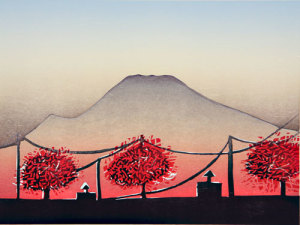
Georgetown Autumn
Q: Were you drawn to Japanese culture?
When I started dating my husband, he lived there, and I spent time with him in Tokyo. I couldn’t speak the language, but I could see how western culture influenced Japan and vice versa. This project came about in part because a friend of mine who lived in Tokyo wanted to organize a show planned at the American Club. Naively, I thought it could be done in a year. Three years later, my friend has moved away from Tokyo, the idea of that exhibit has passed, but the prints are done. I have discovered a process and a medium that feels right.
Q: Now that the “36 Views” are done, what you going to do next?
I have been traveling a lot to Los Angeles recently as my parents are aging. I think I am going to do a series of prints based on Highway One. The windshield is a good frame to start with.

